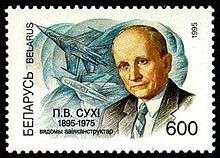Pavel Sukhoi
| Pavel Osipovich Sukhoi | |
|---|---|
 | |
| Born |
July 22, 1895 Hlybokaye, Russian Empire (now Belarus) |
| Died |
September 15, 1975 (aged 80) Moscow, Soviet Union |
| Nationality | Soviet Union |
|
Engineering career | |
| Discipline | Aeronautical Engineering |
| Employer(s) | Sukhoi design bureau |
Pavel Osipovich Sukhoi[1] (Russian: Па́вел О́сипович Сухо́й; Belarusian: Па́вел Во́сіпавіч Сухі́) (July 22, 1895 – September 15, 1975) was a Soviet Belarusian aerospace engineer. He designed the Sukhoi military aircraft until the 1970s, and founded the Sukhoi Design Bureau.[2]
Biography
Sukhoi was born in Hlybokaye near Vitebsk, a small town in Belarus, in what was then the Vilna Governorate of the Russian Empire. He went to school from 1905 to 1914 at the Gomel Gymnasium (now the Belarusian State University of Transport). In 1915 he went to the Imperial Moscow Technical School (today known as BMSTU). After World War I broke out, he was drafted into the Imperial Russian Army; in 1920 he was demobilized because of health-related problems and he went back to the BMSTU, graduating in 1925. In 1925 he wrote his thesis named Single-engined Pursuit Aircraft of 300 hp under the direction of Andrei Tupolev. In March 1925 he started working as an engineer/designer with TsAGI (The Central Aerohydrodynamic Institute) and Moscow Factory Number 156. During the following years, Sukhoi designed and constructed aircraft including the record-setting Tupolev ANT-25 and the TB-1 and TB-3 heavy bombers. In 1932 he was appointed head of the engineering and design department of TsAGI, and in 1938 he was promoted to head of the department of design. He also developed a multi-purpose light aircraft, the Su-2, which saw service in the early years of the Great Patriotic War.
In September 1939, Sukhoi founded an independent engineering and design department named Sukhoi Design Bureau (OKB Sukhoi). Located in Kharkov, Sukhoi was not satisfied with the geographical location of the OKB, which was isolated from the scientific pole of Moscow, and he insisted that the OKB should relocate to the aerodrome of Podmoskovye. The relocation was completed in the first half of 1940. In the winter of 1942 Sukhoi encountered another problem — since he had no production line of his own he had nothing to do. He had developed a new ground-attack plane, the Su-6, but Stalin decided that this plane should not be put into production, favouring production of the Ilyushin Il-2.
In the postwar years, Sukhoi was among the first Soviet aircraft designers who led the work on jet aircraft, creating several experimental jet fighters. From 1949, he fell out of Stalin's favor and was forced to return to work under Tupolev, this time as Deputy Chief Designer. In 1953, the year of Stalin's death, he was permitted to re-establish his own Sukhoi Design Bureau.
During the Cold War, his major serial combat aircraft included the supersonic Su-7, which became the main Soviet fighter-bomber of the 1960s, and interceptors Su-9 and Su-15, which formed the backbone of the PVO. He also pioneered variable-sweep aircraft, such as the Su-17 and the Su-24. He also made a number of projects that were not developed, including the ambitious Mach-3-capable Sukhoi T-3 attack aircraft. The last fighter Sukhoi designed was the T-10 (Su-27) but he did not live to see it fly.
In 1958–1974 Sukhoi served as a deputy of the Supreme Soviet of the USSR. He died in 1975 in Moscow and was buried in the Novodevichy Cemetery.
Awards and honors
- Hero of Socialist Labor (1957), awarded a second "Hammer and Sickle gold medal (1965)
- Lenin Prize (1968)
- Stalin Prize, first class (1943)—for the creation of the Su-6
- USSR State Prize (1975—posthumous)
- Three Orders of Lenin (1945, 1957, 1975)
- Order of the October Revolution
- Order of the Badge of Honour (1936)
- Order of the Red Banner of Labour (1938)
- Order of the Red Star (1933)
- Tupolev Gold Medal—For outstanding work in the field of aeronautical science and engineering (1975)
See also
References
- Bull, Stephan (2004). Encyclopedia of Military Technology and Innovation. Greenwood. ISBN 1-57356-557-1.
- Duffy, Paul (December 1996). Tupolev: The Man and His Aircraft. Society of Automotive Engineers. ISBN 1-56091-899-3.
- Gordon, Yefim (2008). Soviet Air Power in World War II. Midland Publishing. ISBN 1-85780-304-3.
- Pederson, Jay (1998). International Directory of Company Histories, Vol. 24. St James Press. ISBN 1-55862-365-5.
- ↑ Variously romanized as Sukhoy, Sukhoj
- ↑ Central Museum of the Military Air Forces of the Russian Federation